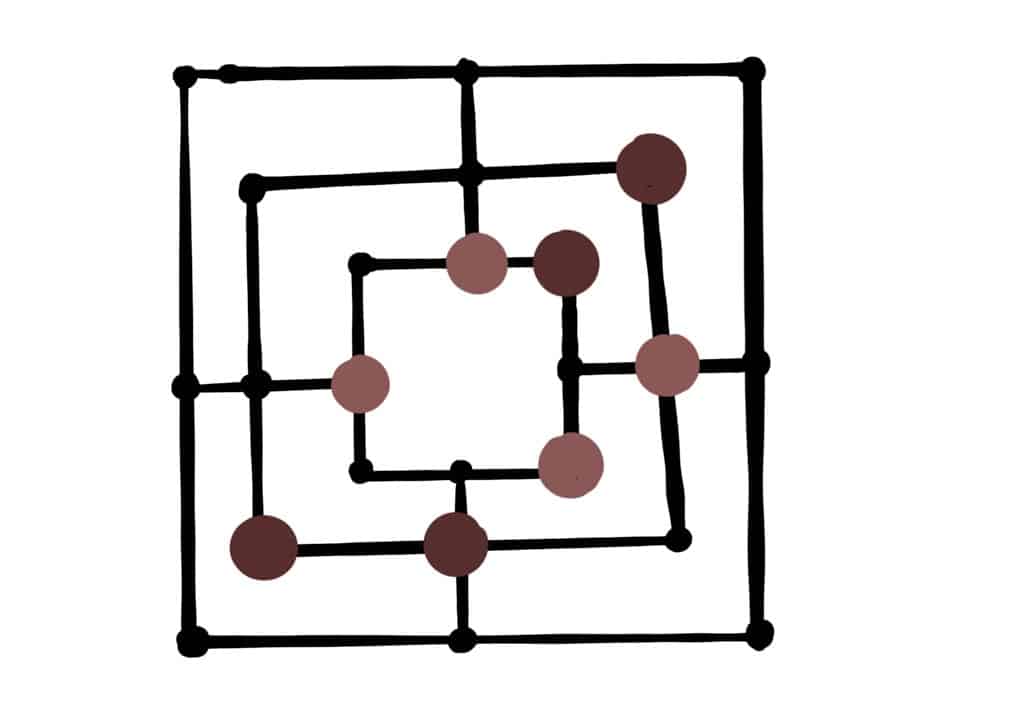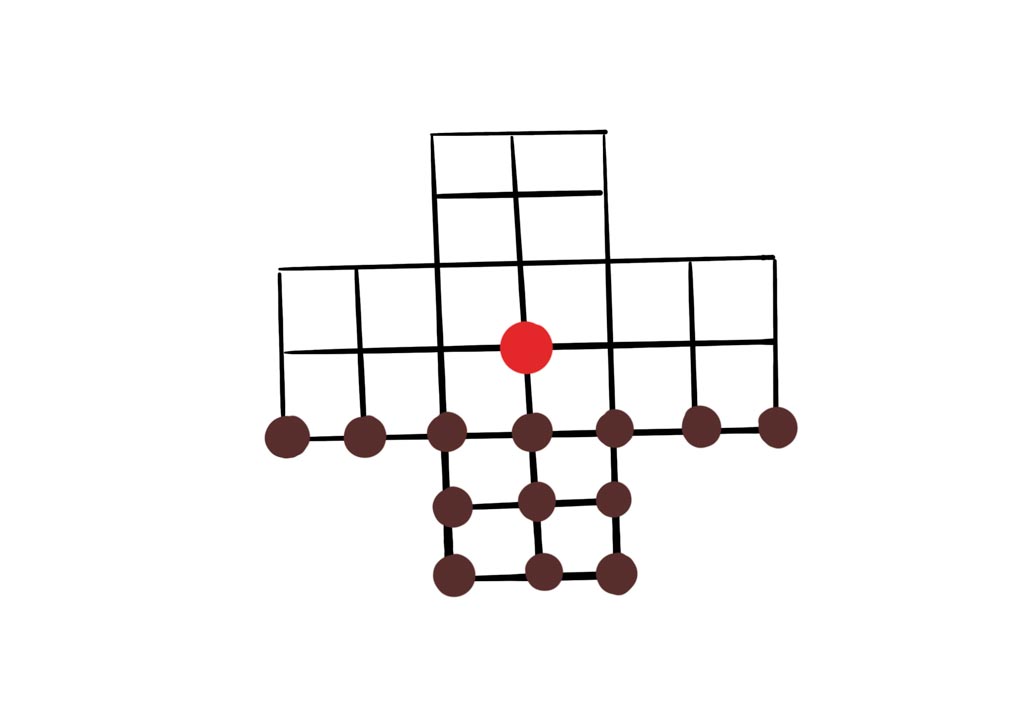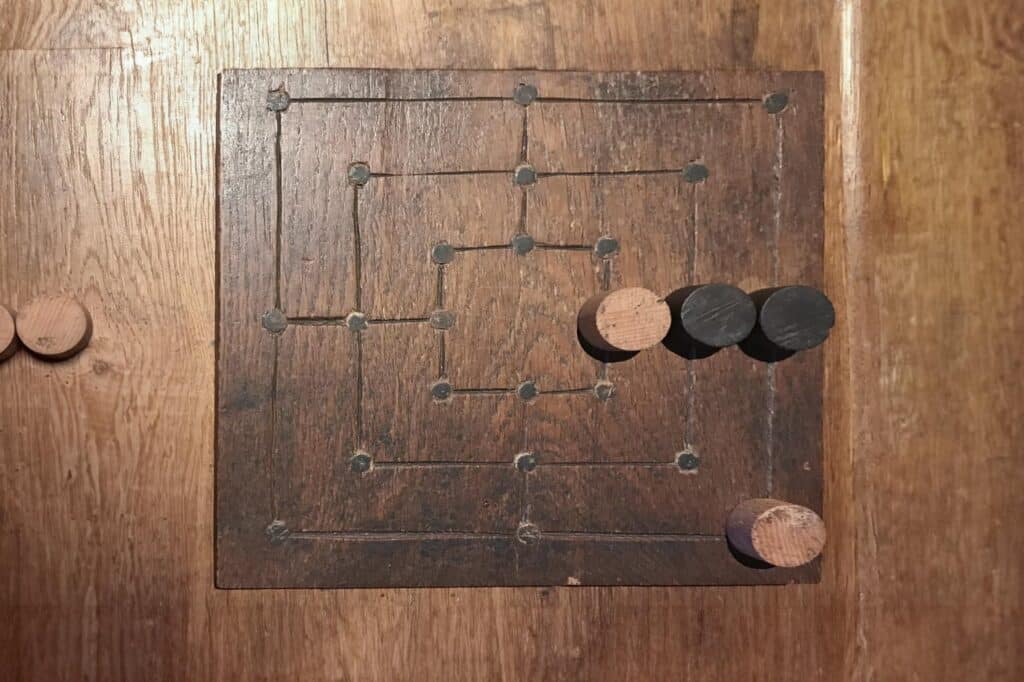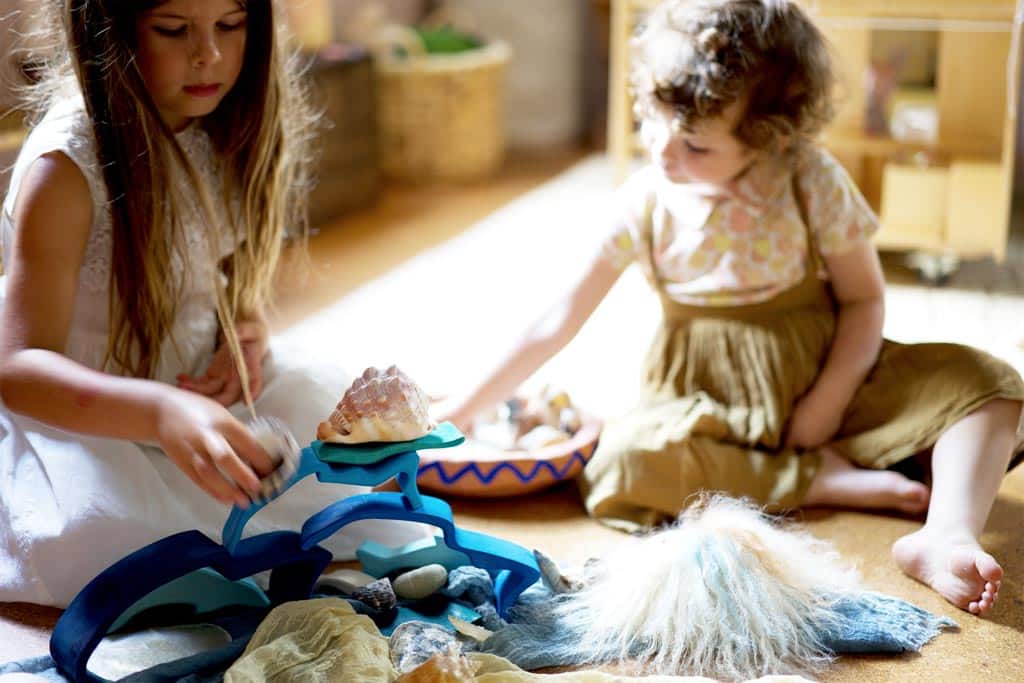Have you tried playing board games yet with your child?
If your child isn’t ready, it can fall apart quite quickly.
She makes mistakes, doesn’t understand the rules, gets frustrated. Having fun has never been so stressful!
What went wrong?
You didn’t choose a developmentally appropriate game.
How to choose the right board game
The trick is, as Maria Montessori said, to start with the child.
What does your child already know? How does she think? Is she able to understand a game?
There’s no point playing Scrabble with a child who can’t read or Monopoly with one who can’t add or subtract.
Those examples are obvious. But what about the more subtle skills?
Let’s take a quick dive into developmental psychology.
How child development limits board game play
Swiss psychologist, Jean Piaget, proposed four stages of cognitive development. Preschoolers sit squarely in the preoperational stage, which stretches from two to seven years.
This is Stage 2. It comes after the sensorimotor stage, when children explore with their senses and through physical activity.
Upon entering the preoperational stage, your child begins to use her mind to tackle problems in her head before she attempts to solve them in the real world.
But preoperational thought is limited.
Here’s a list of all the things your preschooler can’t do. It’s a long list!
Try to view these ‘failings’ in a positive light. Rather than worry about your child’s deficiencies, think how these qualities can guide you to offer the most age-appropriate activities. Chess is out – but Ludo is in! No more tears and upturned playing boards, just fun and engagement.
The ways your child’s thinking is ‘limited’
Egocentrism: Preschoolers in the preoperational stage tend to have difficulty seeing things from another person’s perspective. They often assume that others think and feel the same way they do. This can make games that involve deception, bluffing, or predicting opponents’ moves especially challenging.
- Centration: This concept refers to a child’s tendency to focus on a single, perceptually striking feature of an object or situation, rather than considering multiple aspects simultaneously.It makes it difficult for preschoolers to grasp complex rules, as they tend to focus on one aspect at a time.
- Limited working memory: Your child’s working memory makes it difficult for her to remember and apply multiple rules, keep track of game pieces, or plan several moves ahead.
- Difficulty with abstract thinking: Remember Week 36 (Maths Manipulatives)? Children need concrete materials. Board games that require understanding of abstract principles or symbolic representations may be challenging for them to grasp.
- Impulsivity and self-regulation: Young children don’t like waiting for their turn. It’s tedious.
- Short attention span: How long can your child focus for? Choosing a board game that takes an hour to play is not going to end well. My son was obsessed with history and maps so I foolishly tried to teach him Risk. The poor boy was only five. I don’t think we even got past the set-up stage.
- Incomplete understanding of numerical concepts: Many board games involve counting, adding, or subtracting. If your child can’t do the maths, she will struggle to play the game.
- Language development: Board games often require verbal communication and comprehension of complex instructions. This can be challenging for preschoolers.
OK, let’s reframe this list and make it more positive.
How to help your child engage with board games
- No requirement to anticipate opponents’ moves.
- Simple rules.
- Concrete materials, not abstract ideas.
- Short game time.
- Minimal maths. Counting on and counting back at most.
- Easy language.
Of course, we are moving towards a point where our children can think ahead and strategise, but that comes with age.
And some of the more complicated maths won’t come until the school years. Mentally adding two- and three-digit numbers, a pre-requisite for Monopoly, isn’t realistic for most children until they are seven or eight.
But get it right and your child will enjoy all kinds of benefits.
Recommended games
There’s no need to overcomplicate things.
There’s still time for your child to become a chess champion, if that’s what you want.
But now the focus should be on simple games where your child gets to learn the rules of playing. Even Snakes and Ladders is too tricky if it’s the first time she has played.
Before anything else, the players must be happy with the idea of taking turns – and waiting patiently for the next go.
You will have to lose on purpose, of course. Your child is a bad loser!
So it follows that the best games for young children are those where everyone wins.
Try non-competitive board games, such as those by Peaceable Kingdom.
Something basic, like Hoot Owl Hoot or Count Your Chickens.
Simple counting on. No complicated rules. Roll the die, count correctly and move.
Counting on is a key skill in early maths and – just like with board games – it’s crucial that you don’t count the number you started on.
Orchard Toys also make many games suitable for this stage: The Three Little Pigs, for example.
The above suggestions are for children who are playing for the first time but they will feel slow for a soon-to-be-five-year-old.
If your child has more experience, jump in with some of these classics. But remember to evaluate them against the skills we examined above. Knowing that difficulty strategising puts Chess out of reach, why not modify it and play Pawn Chess instead (see below)?
Classic games
- Snakes and Ladders
- Ludo
- Othello
- Lotto: Traditional bingo games or equivalents with letters, sounds or pictures (Orchard Toys)
Non-competitive games
- Dinosaur Escape, Race to the Treasure, Count Your Chickens, Hoot Owl Hoot (Peaceable Kingdom)
- My First Orchard; The Orchard (HABA)
Games without numbers
- Three Little Pigs (Orchard Toys)
Simplified classics
Junior draughts
Junior Draughts is designed to introduce young children to the basic rules of the game.
- The board is set up as usual but with only six pieces for each player.
- Players take turns moving one of their pieces diagonally along the black squares on the board.
- Pieces can only move forward, never backward.
- Capture opposing pieces by hopping over them.
- The game is won by capturing all of the opponent’s pieces or by blocking them so they cannot move.
Pawn chess
- The board is set up as in a standard game of chess, but with only pawns on the board.
- Each player has four pawns, which are placed on the second and seventh ranks.
- Players take turns moving one of their pawns one or two spaces forward.
- Pawns capture diagonally, as in a standard game of chess.
- The first player to move one of their pawns to the opposite side of the board promotes that pawn to a queen.
- The game is won by capturing all of the opponent’s pawns.
Medieval board games
We took the children to Hampton Court Palace a couple of years ago and they were delighted to discover medieval board games.
The two examples below fall into the category of abstract strategy games – those where there is no story, just strategy, like Othello. This makes them a challenge for younger preschoolers but they are worth a try with an interested four-year-old. Even so, they are probably too tricky for most but I include them here to show you that board games come in many forms. If they appeal, it’s easy to create a simplified version that works for your child.
You don’t need a game board. Draw your own on a piece of paper or – if you are on the beach! – mark out the lines in sand.

Nine Men’s Morris
Nine Men’s Morris is played on a board with a grid of 24 intersections and nine pieces for each player. The objective of the game is to form rows of three pieces (called a mill) either horizontally or vertically. In other words, it’s noughts and crosses, but with the notable difference that you can move your pieces.
- To begin, players take turns to place one piece at a time on the board.
- Once all pieces have been placed, players take turns moving their pieces along the lines from one intersection to another.
- If a player forms a row of three pieces (a mill) either horizontally or vertically, they can remove one of their opponent’s pieces from the board.
- Optional rule: Once a player is reduced to three pieces, they can move their pieces to any empty intersection on the board.
Winning:
- If a player is reduced to two pieces, they lose the game.
- The game can also be won by trapping the opponent’s pieces so they are unable to move.

Fox and Geese
In this unusual game of unequal sides, one player is the fox and the other the geese.
The geese win by trapping the fox; the fox wins by getting behind the geese.
- Place the fox in the centre of the board and the geese along the bottom.
- Players take turns moving their pieces along the lines on the board from one space to another.
- Geese can only move along the lines on the board and can only move forward, diagonally or straight, to an adjacent empty space. Think of a goose as a pawn in Chess. Moving only one space, and never backwards.
- The fox can move along any line on the board to any empty space, including spaces occupied by the geese. The fox is like the queen in chess.
- The fox can capture geese by jumping over them to an empty space beyond. In this way, the game is like draughts.
Winning:
- The game is won by the geese if they surround the fox, leaving it unable to move.
- The game is won by the fox if it captures enough geese so that there are not enough left to trap it (i.e. two)
Card games
If we can agree that the point of playing board games is to encourage turn taking, focus and simple strategising, we see that card games offer many of the same benefits. Here are four to start with:
- Uno
- Snap
- Old Maid
- Go Fish!
Make your own
It’s nice to have a readymade game to play but sometimes it’s fun to make your own. A sheet of A3 paper, a pencil to draw the track and a couple of counters is all you need for a basic game. Use a die or make your own by cutting out a cube net. Or make a spinner with some cardboard and a split pin.
Decorate it any way you like.
Draw Grandma’s cottage at one end and line the route with trees. One counter is Little Red Riding Hood. One is The Big Bad Wolf. Who will get there first!
Final word
Piaget believed that games with rules play an important role in a child’s cognitive development. He proposed that games with rules help children learn to coordinate and regulate their behaviour within a social context, leading to the development of moral and ethical values. They learn how to follow rules, take turns, and think logically about the consequences of their actions.
Much of Get Set Five circles back to pencil control, reading and numbers, and so it is with board games. But games offer so much more.
They teach us to suffer the slings and arrows of outrageous fortune, to meet with Triumph and Disaster and treat those two impostors just the same.
This article comes from our course for preschoolers, Get Set Five. Learn more here.
Are you ready for school?
Do you have a preschooler? Would you like them to develop some key skills before starting school? How wonderful to go into school on that first day feeling like you belong.
Get Set Five is a year-long course full of fun and free activities to do with your child.




